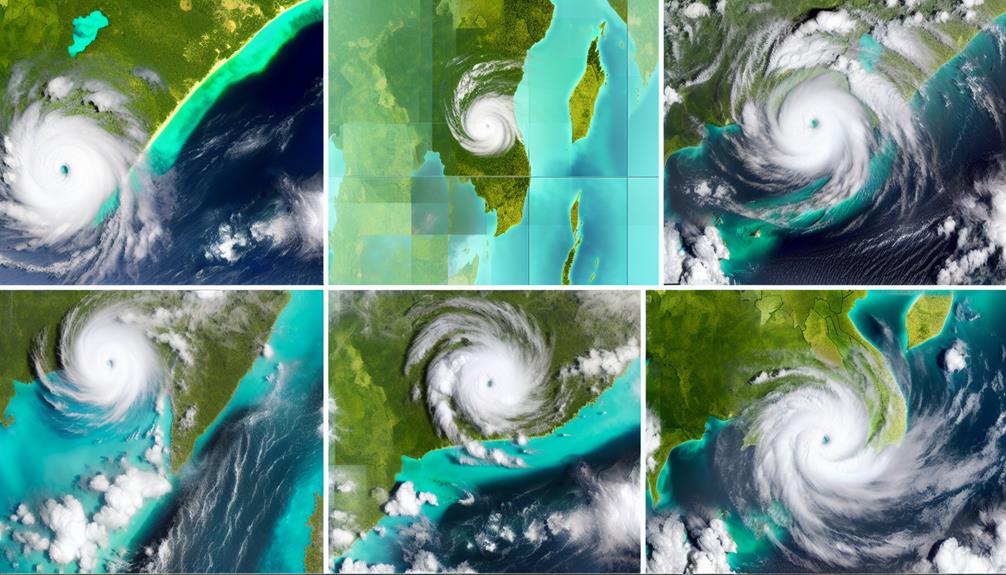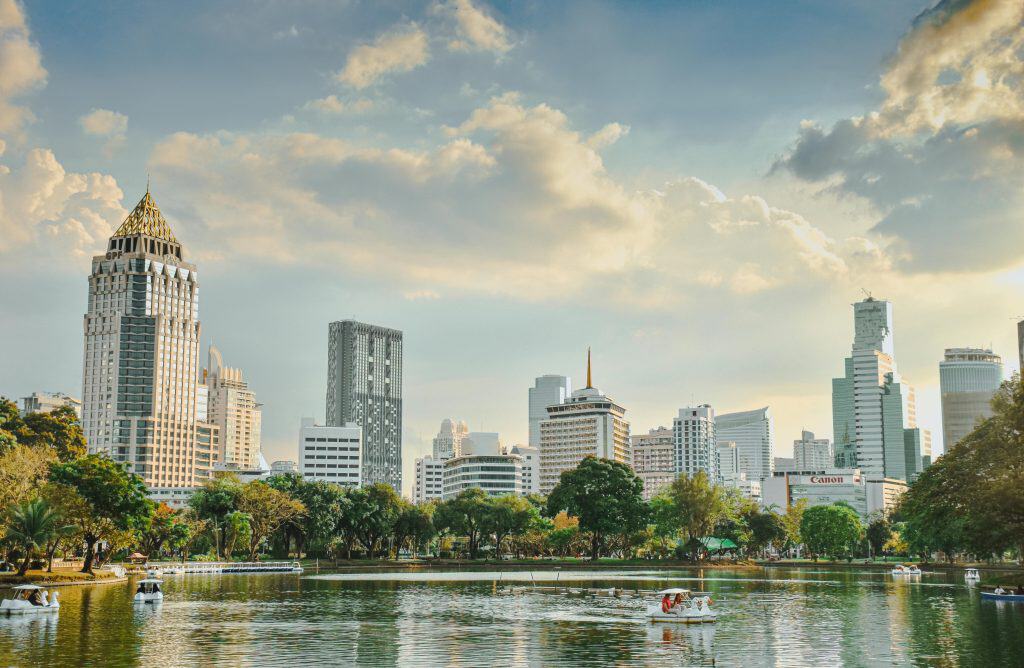As you scroll through the annals of history, you might not expect to find the tales of tropical cyclones among the chronicles of kings and battles, yet they are pivotal in shaping the landscapes and lives in Thailand.
You’ve likely heard whispers of Typhoon Gay or the devastation wrought by Cyclone Nargis, but the stories of these tempests go far beyond mere meteorological footnotes.
In your hands, you hold the power to unravel the impact of these ten historical cyclones, each a maelstrom that has etched itself into the memory of the land and its people.
As you embark on this journey through Thailand’s tempest-tossed past, prepare to uncover the resilience and transformation etched into the nation’s identity by these formidable forces of nature, while pondering the question: what lessons do they hold for a future where such storms may become only more frequent?
Typhoon Gay, 1989
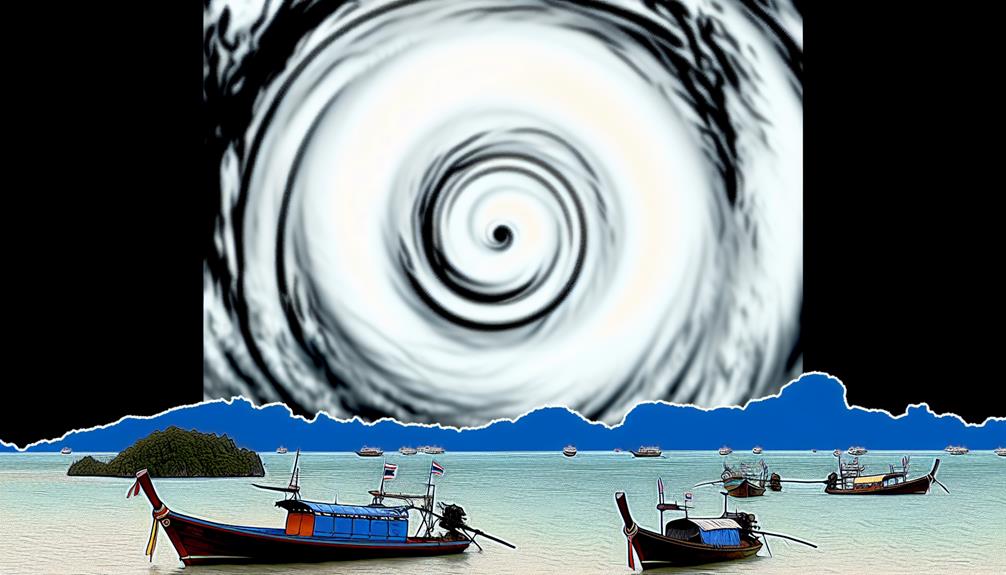
Typhoon Gay, a formidable storm in 1989, devastated parts of Thailand with its fierce winds and relentless rains. You might remember the images of uprooted trees and homes reduced to rubble, painting a picture of nature’s raw power unleashed upon unsuspecting communities. Gay wasn’t just another tropical storm; it was a full-blown typhoon, the kind of which rarely makes landfall in Thailand.
You’d have seen the chaos unfold on November 3rd, when Gay barreled onto the southeastern shores with wind speeds that soared to over 120 miles per hour. You couldn’t help but feel for the families who lost everything in the blink of an eye. It’s estimated that the typhoon affected over 50,000 people, leaving a trail of destruction that took years to rebuild.
You’re aware that Thailand is no stranger to monsoons and tropical storms, but Typhoon Gay’s impact was a harsh reminder of the country’s vulnerability. You’ve learned that the typhoon destroyed thousands of fishing boats, decimated crucial crop fields, and obliterated infrastructure.
In its aftermath, you couldn’t ignore the resilience of the Thai people, who, despite the odds, began the arduous task of piecing their lives back together.
Cyclone Nargis, 2008
While Typhoon Gay shocked Thailand in 1989, it was Cyclone Nargis in 2008 that brought unprecedented devastation to the region, affecting not only Thailand but also leaving a catastrophic imprint on neighboring Myanmar. You might remember the images of utter destruction and the staggering death toll that dominated the headlines. Cyclone Nargis wasn’t just another tropical storm; it was a monster, tearing through the Andaman Sea and slamming into Myanmar on May 2, 2008.
With winds reaching 165 kilometers per hour, Nargis became the worst natural disaster in the recorded history of Myanmar. You’d be shocked to learn that the storm surge reached a colossal three to seven meters, inundating low-lying areas and sweeping away entire communities. The cyclone left behind a trail of chaos, with over 138,000 people dead or missing and millions more affected.
Thailand, while not as heavily impacted, didn’t escape unscathed. The storm’s outer bands brought heavy rainfall, flooding, and property damage. The scale of Nargis’s wrath was a wake-up call for the entire region. It highlighted the need for better disaster preparedness and international cooperation in times of crisis, a lesson you’d hope is well learned for the future.
Tropical Storm Harriet, 1962
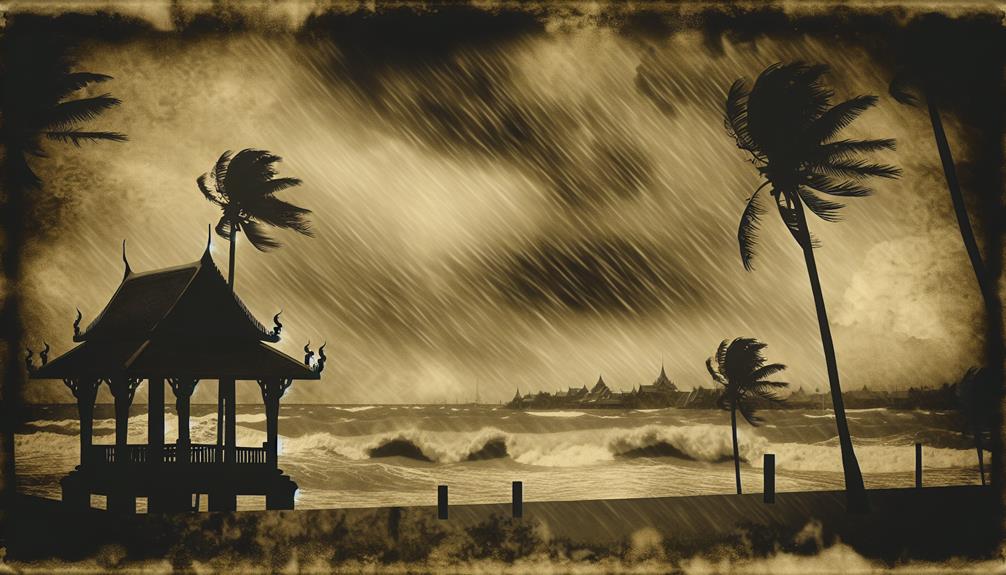
In 1962, Tropical Storm Harriet swept through southern Thailand, claiming over 900 lives and marking one of the country’s deadliest weather events. You’d be hard-pressed to find a more devastating natural disaster in Thailand’s recorded history. Harriet roared ashore with relentless ferocity on October 23, unleashing torrential rains and fierce winds that devastated communities and crippled infrastructure.
You can imagine the chaos as Harriet’s winds tore roofs off houses and uprooted trees, while floods washed away roads and bridges. The storm’s impact was so severe that it wiped entire villages off the map, leaving thousands homeless and without livelihood. Rescue and recovery efforts were hampered by the storm’s aftermath, making it difficult for aid to reach the hardest-hit areas.
As you reflect on Harriet’s legacy, it’s clear that this tropical storm not only shaped Thailand’s approach to disaster preparedness but also serves as a somber reminder of nature’s power. The lessons learned in 1962 have since influenced how Thailand monitors and responds to such calamities, emphasizing the importance of early warning systems and robust emergency planning to save lives and mitigate damage when disaster strikes.
Typhoon Linda, 1997
As Thailand was still grappling with the memories of past storms, the ferocity of Typhoon Linda in November 1997 tested the nation’s disaster response systems anew. You might recall Typhoon Linda as one of the most devastating tropical cyclones to hit the region in decades. Originating in the South China Sea, Linda didn’t just brush past Thailand; it struck with relentless power, particularly impacting the country’s southern provinces.
You’d be right in remembering the aftermath as a period of intense struggle and recovery. Linda claimed over a hundred lives and left thousands homeless. The images of damaged homes, uprooted trees, and flooded streets likely still linger in the collective memory of those who witnessed the catastrophe. It’s a stark reminder of the vulnerability of coastal communities to the whims of nature.
What you might find remarkable isn’t just the scale of the destruction but also the resilience displayed by Thailand’s people. Despite the challenge, the country rallied to rebuild and reinforce its disaster management protocols. Linda’s legacy isn’t just one of loss and damage; it’s also a testament to human tenacity and the continuous effort to safeguard against future calamities of such magnitude.
Tropical Storm Vae, 1964
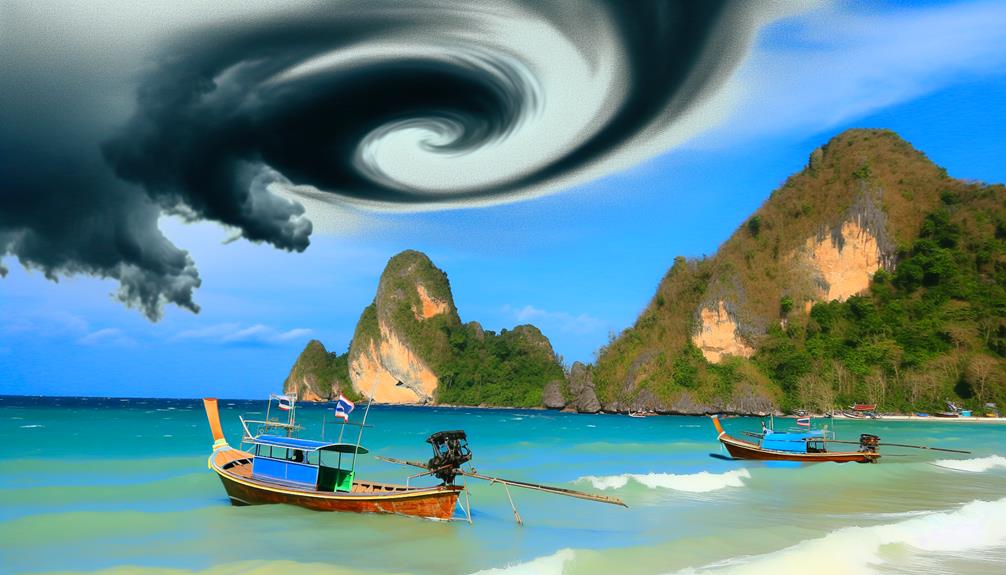
Decades before Typhoon Linda’s onslaught, Tropical Storm Vae swept through Thailand in 1964, unleashing devastating floods and marking one of the country’s earliest encounters with such a natural disaster. You mightn’t find Vae’s name etched deeply in the collective memory like other infamous storms, but its impact was profoundly felt across the nation.
As Vae churned towards Thailand, you can imagine the apprehension gripping the hearts of locals, unaccustomed to dealing with the ferocity of tropical storms. When Vae struck, it didn’t hold back. Heavy rains pounded the region relentlessly, rivers swelled beyond their banks, and floodwaters rose, submerging homes and farmland. You’d see the aftermath as a tableau of destruction and human resilience.
The storm’s legacy wasn’t just the immediate devastation. In the wake of Vae, you’d witness a nation grappling with the harsh realities of tropical weather. It spurred improvements in meteorological services and disaster preparedness—a silver lining in an otherwise dark cloud.
The lessons learned from Vae’s wrath contributed to shaping the robust response strategies you see in Thailand today, ensuring that the country is better braced to weather the storms of the future.
Cyclone Mala, 2006
Nearly two decades after Tropical Storm Vae, Cyclone Mala roared into Thailand in April 2006, leaving a trail of destruction in its wake. You might recall the apprehension as Mala grew from a tropical disturbance into a formidable Category 4 cyclone, with winds howling up to 240 kilometers per hour. It’s not every year you witness such a powerful storm targeting the Andaman Coast and parts of Myanmar.
The impact was severe. You saw homes flattened, power lines toppled, and trees uprooted like they were mere twigs. Flooding ensued, roads became impassable and, tragically, lives were lost. You can’t forget the haunting images of damaged boats, testimony to the livelihoods washed away in the blink of an eye.
After the storm passed, the resilience of communities shone through. You were part of the cleanup efforts, rebuilding what nature had swiftly undone. It was a humbling reminder of the power of the elements and the importance of preparedness.
Cyclone Mala didn’t just etch itself into the history books; it engraved a lesson in the collective memory of Thailand. You now know all too well that the tropics, while beautiful, demand respect and caution, especially during cyclone season.
Typhoon Patsy, 1970
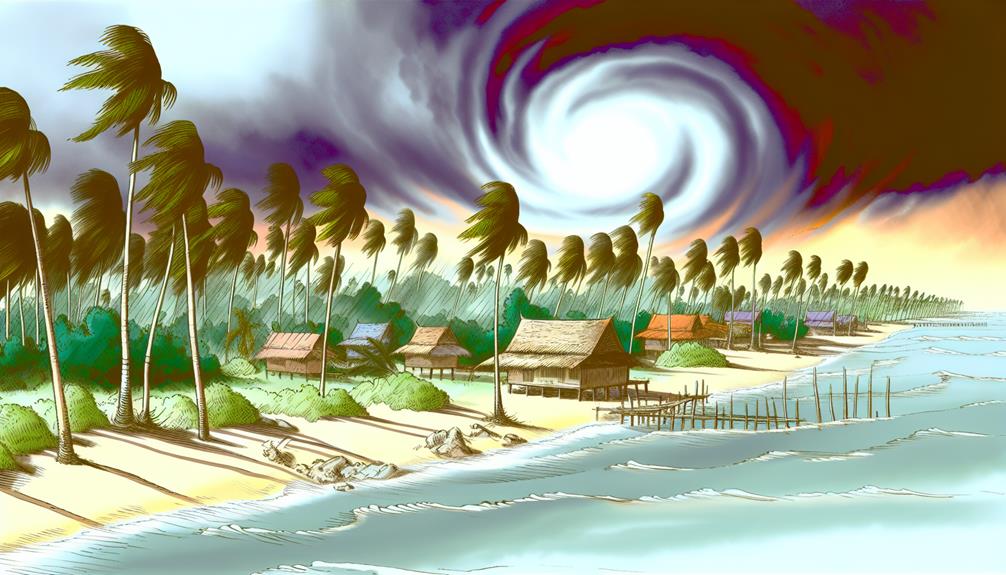
Reflecting on the devastation wrought by Cyclone Mala, it’s crucial to remember Typhoon Patsy as another significant event that tested Thailand’s resilience back in November 1970. Known in the Philippines as Yoling, Typhoon Patsy was a violent tropical system that wreaked havoc across Southeast Asia, leaving a trail of destruction in its wake.
You mightn’t know that Patsy first developed as a tropical depression near the Caroline Islands. As it tracked westward, it intensified rapidly, reaching typhoon strength and then slamming into the Philippines with catastrophic effects. But its fury didn’t stop there; it continued its onslaught, moving into the South China Sea.
By the time Patsy reached the shores of Thailand, it had weakened slightly but still packed a powerful punch. You’d be astonished by the damage it caused—homes destroyed, crops decimated, and lives upended. The typhoon’s heavy rains led to severe flooding, which compounded the misery for those affected.
While it’s not as widely remembered as some other storms, Typhoon Patsy stands as a stark reminder of nature’s raw power and the need for effective disaster preparedness. It’s a lesson that’s as relevant today as it was back then, as you strive to protect lives and livelihoods against such relentless forces.
Tropical Storm Thelma, 1991
In 1991, Tropical Storm Thelma unleashed torrential rains and triggered catastrophic flooding, particularly in the Visayas region of the Philippines, before its remnants affected Thailand. You might better remember Thelma by its Filipino name, Uring, which devastated the Philippines in early November that year. But it’s the storm’s impact on Thailand that’s your focus here.
After wreaking havoc in the Philippines, Thelma’s remnants brought heavy rainfall to Thailand. While not as destructive as it was in the Philippines, you shouldn’t underestimate the effects it had on the region. The rains caused rivers to swell, leading to flooding in several provinces. You’d find that agriculture suffered significantly, with damage to crops and livestock impacting local economies.
You may be wondering about the response. Well, Thai authorities were quick to implement emergency measures, including evacuation of flood-prone areas and distribution of relief goods. Thelma serves as a reminder that even the remnants of a tropical cyclone can have serious consequences. And while it mightn’t be the most infamous storm to hit Thailand, Thelma’s legacy is a testament to the country’s resilience and ability to manage tropical storm threats.
Cyclone Forrest, 1983
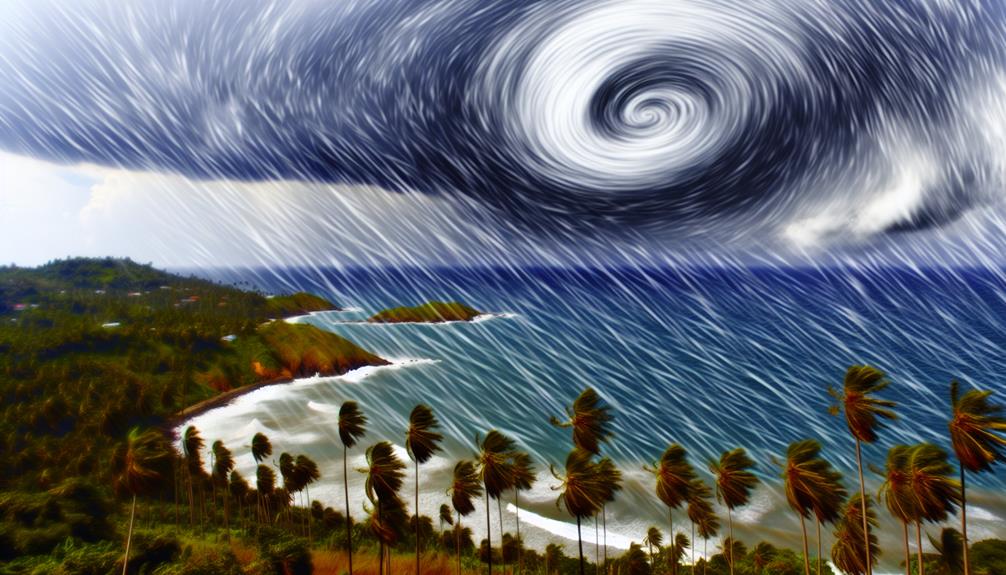
Cyclone Forrest in 1983 carved a path of destruction through Thailand, leaving a mark on the nation’s history with its severe weather impacts and resultant economic toll. As you delve into the archives, you’ll find that Forrest wasn’t just any storm—it was a powerhouse that brought widespread devastation.
You mightn’t have been there, but imagine the chaos as Forrest, packing relentless winds and torrential rains, slammed into Thailand’s landscape. It didn’t just uproot trees and homes; it shattered lives and livelihoods. The cyclone’s fury disrupted communication lines and infrastructure, making relief efforts a daunting task.
As you learn about Forrest’s aftermath, you’ll be struck by the resilience of the Thai people. Despite the extensive damage, communities banded together, rebuilding what was lost and fortifying against future calamities. Forrest’s legacy isn’t just a tale of destruction—it’s a story of human tenacity and the relentless spirit to overcome.
The economic impact was staggering, too. You’d see figures that underline the cost of rebuilding and recovery, revealing the broader implications of such natural disasters on a developing economy like Thailand’s. Forrest serves as a sobering reminder of nature’s might and the importance of preparedness and response strategies for tropical cyclones.
Typhoon Angela, 1995
Twelve years after Cyclone Forrest’s rampage, Typhoon Angela struck Thailand with a ferocity that echoed past devastations, reaffirming the nation’s vulnerability to powerful storms. You might remember Angela as one of the most intense typhoons of the 1995 season, not just for Thailand, but for the entire Western Pacific region. Originating near Guam and reaching peak intensities equivalent to a Category 5 hurricane, Angela carved a path of destruction that you’d recall for the ages.
As Angela approached, you’d have braced for the worst. The typhoon barreled through the Philippines before reaching Thailand, and you can’t help but recall the anxiety that gripped the nation. It’s not every day that you’re faced with winds that can tear roofs off and turn harmless objects into dangerous projectiles.
Thankfully, Thailand was spared the brunt of Angela’s wrath, as the storm weakened considerably before making landfall. Nevertheless, the impact was still severe with heavy rains causing flooding and landslides, disrupting lives and livelihoods. You’d remember how communities came together, bolstering relief efforts and rebuilding what was lost. Angela wasn’t just a storm; it was a testament to Thailand’s resilience in the face of nature’s fury.
Frequently Asked Questions
How Have Historical Tropical Cyclones Influenced Thailand’s Building Codes and Infrastructure Development?
You’ve seen how severe storms shape laws; Thailand’s building codes and infrastructure have evolved significantly to withstand the impact of tropical cyclones, ensuring better safety and resilience against these natural disasters.
What Are the Long-Term Socioeconomic Impacts on Affected Communities Years After These Major Tropical Cyclones?
You’ll find that major tropical cyclones often leave lasting socioeconomic impacts, including altered community structures, long-term economic hardship, and changes in local demographics due to migration and the loss of livelihoods.
How Has the Thai Government’s Disaster Response and Evacuation Planning Evolved as a Result of These Significant Tropical Cyclones?
You’ve seen improvements in disaster response and evacuation plans since significant storms struck. The government’s learned from past events, enhancing readiness and reducing the potential impact on communities throughout Thailand.
What Role Have Traditional Thai Cultural Practices and Beliefs Played in the Recovery and Healing Process After These Devastating Storms?
You’ve seen how traditional Thai cultural practices and beliefs foster resilience, aiding in recovery and healing after storms through communal rituals and spiritual support that unite and uplift affected communities.
What Are the Unique Challenges Faced by Thailand’s Wildlife and Natural Ecosystems in the Aftermath of These Severe Weather Events?
You’ll find that Thailand’s wildlife and ecosystems face habitat destruction, food scarcity, and disrupted migration patterns following severe weather, posing unique challenges for conservation and recovery efforts.
Conclusion
You’ve journeyed through the devastating impacts of Thailand’s most severe tropical cyclones. From Typhoon Gay’s wrath in ’89 to Angela’s fury in ’95, these storms have shaped history, challenged resilience, and reminded us of nature’s might.
Reflect on the power of these events and the importance of preparedness. As the tropics continue to brew tempests, let’s honor the lessons learned and strive to safeguard communities for a more secure and resilient future.

